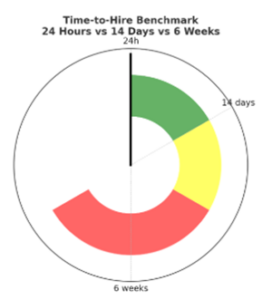The Future of Fair, Fast, and Compliant Hiring
12 minutes
A Talent Acquisition Thought Leadership Whitepaper
Framing: A research-led perspective on how AI and hyper-automation are reshaping talent acquisition – balancing speed, compliance, and fairness.
Researched & Written by Mark Stephens
Commissioned by Tom Wood, Talent Matched Ltd
A summary version, extracted from our Academic Research paper.
Abstract
Enterprises and MSPs face a hiring squeeze: surging application volumes, thin recruiter capacity, rising candidate expectations, and tightening regulation. This paper integrates three critical lenses – the economic cost of delay, regulation as competitive driver, and fairness by design – and shows how AI at scale resolves the speed–compliance–fairness trilemma.
We synthesise recent evidence and frameworks from Gartner and McKinsey, plus peer-reviewed and preprint scholarship, and operationalise it into a transformation path that aligns with TalentMatched’s value proposition: audit-ready, mathematically bias-neutral AI that produces qualified shortlists in 24 hours and integrates with existing ATS.
Recommendations are framed for : CHRO/CPO, TA leadership, Compliance/IT, and CFO stakeholders.
Part 1: AI at Scale – The Future of Fair, Fast, and Compliant Hiring
Introduction
Hiring has always been a competitive advantage, but in today’s labour market, speed, compliance, and fairness are no longer optional – they are existential. Organisations face unprecedented application volumes, rising regulatory scrutiny, and increasing candidate expectations of fairness and transparency.
As McKinsey notes, “AI adoption is no longer a question of technology readiness, but of leadership, trust, and change management” (McKinsey, 2025). For talent leaders, the question is no longer if they should adopt AI, but how quickly they can scale it responsibly.
“AI adoption is no longer a question of technology readiness, but of leadership, trust, and change management. – McKinsey (2025)”
“B2B trust is the new competitive currency. – Forrester (2023)”
The Economic Cost of Delay
Every day of delay in hiring comes with measurable costs: lost productivity, higher attrition, and candidates slipping to competitors. UK benchmarks suggest average time-to-hire exceeds 30 days, with NHS roles stretching far longer (REC, 2024). Yet top candidates accept offers within 72 hours of entering the market (StandOut CV, 2024).
This misalignment leads to painful questions:
- How many of your best candidates are lost simply because your process is too slow?
- What is the weekly cost of vacancy across critical roles in healthcare, logistics, or QSR?
McDonald’s UK faced this very issue – managing 1M+ monthly applications. By introducing automated shortlisting, time-to-hire was reduced by over 60%, proving that speed is not just operational, but strategic.
Regulation as a Driver
The compliance landscape has shifted dramatically. The EU AI Act explicitly classifies recruitment AI as high-risk, requiring risk management, transparency, and post-market monitoring. Fines can reach €20M – a figure already tested by GDPR enforcement (EDPB, 2022).
Gartner (2025) frames this not as a technical issue, but as a governance challenge: “Trust and compliance have become the deciding factors in enterprise AI adoption.”
The real question for leaders is: Are your current systems audit-ready if the regulator came knocking tomorrow? If not, adoption of compliant AI is not optional – it is a competitive differentiator.

Fairness by Design
Bias in recruitment is no longer a reputational risk – it is a legal and commercial one. Robert et al. (2020) call for fairness to be built in “by design,” linking recruitment AI to distributive and procedural justice. Candidate research echoes this: trust rises when AI is transparent, but collapses if perceived as biased (Horodyski et al., 2023).
While some vendors bolt on fairness checks post-hoc, evidence suggests this approach is insufficient (Nosratabadi et al., 2022). Fairness must be mathematical, explainable, and audit-ready from day one.
Case Evidence
- McDonald’s UK – cut time-to-hire from 21+ days to 7 days across 200+ sites.
- Zoom – reduced recruiter admin load by 25% and improved cultural fit scores.
- Focus Cloud Group – decreased time-to-submit by 64%, freeing consultants for higher-value work.
These examples are not outliers – they illustrate what enterprises in healthcare, logistics, and construction could achieve with responsible AI adoption.
The Transformation Path
So how do organisations embrace high-volume TA transformation?
- Assess and Align: Identify bottlenecks, map compliance gaps, set ROI and DEI objectives.
- Augment, Don’t Replace: Integrate AI with existing ATS, rather than rip-and-replace.
- Instrument for Trust: Provide transparency notices, fairness audits, and candidate appeal routes.
- Scale with Governance: Adopt RACI models and quarterly audit reviews to stay ahead of EU AI Act obligations.
The organisations that act now will move faster, hire better, and reduce compliance risk. Those that delay risk both regulatory sanction and market irrelevance.

Part 2: Beyond Speed – Redefining Trust and Fairness in AI-Driven Recruitment
Introduction: Why Faster Hiring is Not Enough
Speed solves part of the equation, but as Forrester (2023) reminds us, “B2B trust is the new competitive currency.” Faster hiring without fairness and transparency risks eroding candidate trust, DEI commitments, and brand reputation.
Ask yourself: if your candidates knew exactly how your AI made decisions, would they trust it?
The Crisis of Slow Hiring
Healthcare systems are losing nurses not just to global shortages, but to bureaucratic delays. Logistics firms miss seasonal demand peaks because recruitment teams cannot process thousands of applications quickly enough. The cost is not abstract – it is measured in lost capacity, service delays, and revenue leakage.
The Compliance Tipping Point
The EU AI Act marks a watershed moment. Recruitment AI cannot be a black box – it must be auditable, transparent, and explainable. Leaders now face a choice: adopt compliant AI voluntarily, or be forced to under scrutiny.
As PwC (2024) notes, “Compliance-first design is rapidly becoming a buying criterion in enterprise procurement.”
Bias-Neutral AI as Competitive Advantage
Bias-neutral AI is not just a DEI initiative – it is a source of competitive edge. Firms that widen their talent pool by mitigating bias will not only avoid litigation, but also hire better. Evidence suggests diverse teams deliver up to 35% higher financial returns (McKinsey, 2020).
Can your organisation afford to exclude talent because of outdated or biased systems?
Human + AI Partnership
Critics argue AI dehumanises recruitment. But evidence shows the opposite: automation frees recruiters from repetitive CV triage, giving them time for human engagement. In pilots, recruiter adoption exceeded 80% within 30 days when AI handled admin tasks, not decisions.
This aligns with Gartner’s (2025) finding that “AI empowers recruiters when it augments, not replaces.”
Conclusion: AI Hiring You Can Trust
The future of recruitment is not just faster – it is fairer and more transparent. Enterprises that act now can transform their hiring economics, protect compliance, and rebuild candidate trust. Those that delay face higher costs, lost talent, and reputational risk.
The question for every CHRO and TA leader is simple: Do you want to be explaining to your board why you lost talent – or showing them how AI gave you the edge?
References (APA 7 Style) – Selected
- Robert, L. P., et al. (2020). Designing fair AI for managing employees. Human–Computer Interaction.
- Horodyski, P., et al. (2023). Applicants’ perception of AI in recruitment. Journal of Behavioural and Experimental Economics.
- Recruitment & Employment Confederation. (2024). UK Recruitment Industry Status Report 2023/24.
- European Commission. (2025). EU AI Act Framework.
- Gartner. (2025). AI in HR: Legal Leaders’ Guide.
- McKinsey & Company. (2025). Superagency Report.
- Forrester. (2023). B2B Trust Imperatives.
- StandOut CV. (2024). Hiring Timelines Report.

🌐 TalentMatched Bio
TalentMatched is redefining high-volume recruitment with AI at scale – delivering fair, fast, and compliant hiring for enterprises and MSPs. Our patent-pending Symmetrical Bias Vector Engine guarantees mathematically bias-neutral shortlists, while our platform processes 1M+ applications per month without compromise on compliance or transparency.
With audit-ready artefacts across nine jurisdictions, 24-hour qualified shortlists, and seamless ATS integrations, TalentMatched empowers CHROs, TA leaders, and Compliance teams to reduce time-to-hire by 50%, protect against £20M+ GDPR/AI Act fines, and prove 400% ROI in less than 90 days.
We don’t replace recruiters – we give them back the time to focus on what matters: engaging and hiring the best talent.
- 📊 See your ROI: Try our [ROI Calculator] to uncover hidden hiring costs.
- 🛡️ Stay compliant: Download the [EU AI Act Checklist for TA Leaders].
- 🚀 Transform hiring in 90 days: [Book a demo] and discover how TalentMatched delivers 24-hour, bias-neutral shortlists at enterprise scale.
Get your first 100 CV screens free
Ready to stop drowning in unqualified applications and start surfacing quality candidates?
✓ No credit card required
✓ Set up in under 2 minutes
✓ Integrates with your existing systems
✓ Cancel anytime





